| Reviews & Columns |
|
Reviews DVD TV on DVD Blu-ray 4K UHD International DVDs In Theaters Reviews by Studio Video Games Features Collector Series DVDs Easter Egg Database Interviews DVD Talk Radio Feature Articles Columns Anime Talk DVD Savant Horror DVDs The M.O.D. Squad Art House HD Talk Silent DVD
|
DVD Talk Forum |
|
|
| Resources |
|
DVD Price Search Customer Service #'s RCE Info Links |
|
Columns
|
|
|
Superman Ultimate Collector's Edition
Warner Bros. // PG // November 28, 2006
List Price: $99.98 [Buy now and save at Amazon]
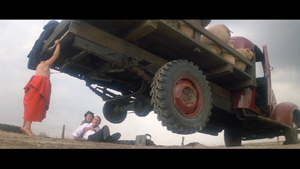 Warner Brothers' 14-disc "Superman: Ultimate Collector's Edition" box set is a mammoth collection of five Superman movies, a bonus sixth movie, an expanded edition of one film, a long-awaited director's cut of another, two feature-length documentaries, all of the Max Fleischer Superman cartoons, a rare television pilot, and enough bonus material to keep a Supes fan busy for the better part of a month.
Warner Brothers' 14-disc "Superman: Ultimate Collector's Edition" box set is a mammoth collection of five Superman movies, a bonus sixth movie, an expanded edition of one film, a long-awaited director's cut of another, two feature-length documentaries, all of the Max Fleischer Superman cartoons, a rare television pilot, and enough bonus material to keep a Supes fan busy for the better part of a month.For those not yet aware of the contents, please note that this box set is one of two being released by Warner Bros., the other being the "Superman: The Christopher Reeve Collection." Both sets collect the four-disc "Superman" special edition, the two-disc "Superman II" special edition, and the single disc "Superman III" and "Superman IV" deluxe editions. The "Ultimate Collector's Edition" adds to this the two-disc "Superman Returns" special edition, the "Superman II: The Richard Donner Cut" disc, and the documentary "Look! Up in the Sky," each of which have also been given individual releases. The "Ultimate" set then adds two discs of bonus material exclusive to this box. It's easy to admire Warner Bros.' decision to grant Superman fans the ability to pick and choose just how much Superman material they want to own.
The "Ultimate Collector's Edition" comes in a gorgeous oversized silver tin (similar to the one used for the recent "Forbidden Planet" special edition). Inside, we get a flipbook-style digipak (one disc per tray, no overlapping) with a snazzy lenticular cover that shows Superman in flight, crashing through his "S" shield. The discs have been given special artwork to separate them from their individual releases - with the odd exception of "Look! Up in the Sky," which mysteriously maintains its original art. A foam strip is inserted into the tin to keep the large digipak from rattling around inside.
The digipak also carries holds a mini reprint of "Superman" issue no. 7 (from 1987), with script and art by John Byrne; the glossy booklet ends with reprints of several other Superman comic covers from more recent years. The chapter/bonus material index comes in a nifty faux-edition of the Daily Planet, dated Nov. 28, 2006. A nice touch.
Finally, a mail-in offer to receive full-size reprints of the movie posters for all four Reeve-era movies plus the new "Superman Returns" is included.
Now it's on to the actual content of the discs, all those movies and extras. It's best to break things down film by film, disc by disc.
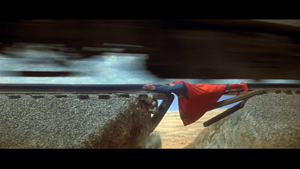 Disc One: "Superman" Original Theatrical Version
Disc One: "Superman" Original Theatrical Version"Easy, miss. I've got you."
"You've got me?! Who's got you?!"
Is there any piece of film music more rousing that John Williams' theme to "Superman?" Every time I hear it, I feel a swell of emotion inside, and for just a moment, I think that maybe, just maybe, I just might be the Man of Steel. It's the kind of hummable, pomp-heavy overture that brightens my day, makes me stand up straight, and fools me into thinking everything's going to be fine with the world.
It's the perfect fanfare to begin what still remains the single best superhero movie ever made. Richard Donner's "Superman" is a brilliant combination of high adventure, Biblical epic, and comic action. It knows exactly when to take itself seriously and when to kid itself.
The film is essentially split into two parts. The first is the 70s-era "origin of Superman" legend, presented with all the pageantry of a widescreen epic. Here, Supes becomes one part Moses and two parts Jesus as Jor-El (Marlon Brando) spares his son the fate of dying on his home world by sending him to planet Earth, where his superpowers will make him into a savior of sorts.
These early Krypton scenes come complete with faux-Shakespearean dialogue and a larger-than-life plot, the kind of material you would find not only in a DeMille film, but also in the comics of the day. In addition, the design of the planet, an ice planet powered by crystals, showcases an imagination eager to stretch to new limits. Unwilling to settle with just some generic "snow world," the filmmakers present a world unlike any we'd ever seen on film before. As a result, Krypton becomes a feast for the eyes and a treat for the imagination.
Moving on to Kansas. Here, the facts of the Superman legend - found as a baby by Ma and Pa Kent, raised in Smallville, forced to hide his powers while he struggles to understand them - are presented with a solid earnestness. It's here we get our first impression of Superman as pure Americana, with Donner giving us sweeping widescreen shots of Kansas farmland. It's as if young Kal-El/Clark Kent landed smack dab in the middle of a John Ford movie.
Young Clark learns the American Way of Life at its best (and its cheesiest). Work hard. Be honest. Help others. And when Pa Kent (Glenn Ford) dies of a heart attack immediately after dispensing some homespun wisdom to his adopted son, Clark then must take his voyage of discovery, leaving home, learning about his past, confronting the ghost of his home world (literally), and finally emerging as a man - as Superman, in fact, costume and all. All of this is once again given near-Biblical importance, the filmmakers understanding that Superman is our modern myth. The subject matter is given a kind of awestruck respect befitting a true icon, a move unexpected in the days in which four-color characters were still looked upon as figures of childish silliness.
Now, a movie has to be quite ballsy to be about Superman and not show the hero in his full blue-and-red-tights glory until the fifty minute mark. And even then, it's just a brief glimpse; the hero's real debut comes another twenty minutes later - almost halfway into the movie. By holding its main character back, by presenting so much exacting detail into his past, the producers make their movie more than just another cheap comic adventure. By doing this, they get the audience to take the character seriously. That way, when we get to the film's second half (and the complete change in style that comes with it), we're ready to accept it.
The film's second half comes with the arrival of Clark Kent (Christopher Reeve) in Metropolis. The tone lightens, the cast and crew have more fun with the material, and there's more room for comic relief. It becomes, in Donner's words, "a comic book." The mood is lighter, the jokes broader, the atmosphere breezier.
It's also here that we finally get to the "real" plot. Lex Luthor (Gene Hackman), the self-proclaimed "greatest criminal mind of our times," is busy planning Superman's demise while also working on a scheme to destroy the California coastline. Meanwhile, Lois Lane (Margot Kidder) finds herself falling in love with the Man of Steel, and vice versa.
While the first half of the film contains some memorable scenes - the Krypton high council, the destruction of Krypton, baby Clark holding the truck, teen Clark chasing the train - it's the Metropolis segment that gives us the movie's key images. The helicopter disaster that introduces Superman to the world. The midnight flight with Lois. Supes' meeting with a cat burglar. The rescue of a school bus. The makeshift railroad track. The reversal of the planet itself, which, despite insanely faulty comic book science, is one cool move. The "Superman" movie has given us some of the most indelible sights of modern movie history (most of which work thanks to the groundbreaking special effects which, for the first time, showed completely believable human flight).
Often forgotten amidst the thrilling action set pieces, the giddy comedy, and the epic storyline is a fantastic performance from the movie's star. Reeve is essentially playing two roles here: the sincere, dreamy, bigger-than-life Superman and the frumpy, klutzy, nerdy Clark. This double act may not make sense to modern viewers, who are used to the revamped Superman legend that presents Clark as a normal guy, not as a geek. But at the time, this was how Clark was, and for a good reason. Who would ever suspect mild-mannered Clark Kent, who fumbles his way through life without an ounce of grace, could possibly be the suave, confident Superman?
For all those who joke about how glasses alone turn Superman into Clark Kent, watch Reeve at work here. The actor has created two fully realized, fully separate characters, and it's stunning to watch him alternate between the two. In one scene, Clark removes his glasses to reveal himself as Superman; the body transformation is remarkable. With a shift in body language and a quick inflation of his chest, Reeve turns himself into a whole different character within just a few seconds. That's some piece of acting, taking arguably the silliest of the comic's contrivances and making it look like it could actually work.
With such a serious take on the character, "Superman" builds itself into a fully believable chunk of fantasy. It works because it believes in itself. Despite its comic leanings in later scenes, not once does the film ever become camp. It's as honest a picture you could want about the world's most powerful Boy Scout.
But above all, it's just a great time. The action is exhilarating, the comedy is delightful, the characters warm and likable. This is movie entertainment in its purest form. Donner and his filmmaking crew grab hold and take you into their own wonderful world, a place where, for two and a half hours, you honestly believe a man can fly.
Video & Audio
The film has been fully restored, and the work shows. The anamorphic widescreen (2.35:1) image is pristine, with a bit of unavoidable softness revealing the film's age but everything else letting the film shine. Choose between a remastered Dolby 5.1 mix, the film's original stereo soundtrack (see the note at the end of this review for a detail on this), and a French stereo dub. Optional subtitles are available in English, French, and Spanish.
Extras
The commentary from producers Ilya Salkind and Pierre Spengler is, disappointingly, a big snooze, thanks to Spengler's drab monotone and Salkind's penchant for self-praise. It's chatty, but not much fun.
Also on this disc are the film's teaser trailer and theatrical trailer and a TV spot (all in anamorphic widescreen - yes, even the TV spot, strangely enough).
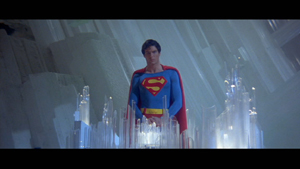 Disc Two: "Superman" Expanded Edition
Disc Two: "Superman" Expanded EditionFrom the beginning, "Superman" has existed in several alternate forms. A few years after its theatrical release, producers Alexander and Ilya Salkind pieced together a much longer version of the movie - without any input from Richard Donner - for international release. When ABC obtained the rights to broadcast the film, they took the Salkinds' "international cut," trimmed a few scenes, and aired it as a two-part, two-night movie event.
The original theatrical version returned to favor following its release on home video, and a new cut wouldn't come around until 2000, when Warner Bros. invited Donner to create a new, spiffed-up version, this one called the "expanded edition." The film print was polished (while, mercifully, leaving the original special effects alone), the soundtrack was remixed in Dolby 5.1 (with some new sound effects replacing old ones that were no longer usable, which caused a bit of a stir among fans and purists), and a handful of scenes (chosen from the 45-some minutes of added material which had previously appeared in the international and ABC edits) were fully restored and edited into the film.
The intent was to give the film a special edition theatrical re-release, as had been done for "Star Wars." The plans fell through, however, and Warner Bros. instead used this version of the movie for their first DVD release of the title, which arrived in stores in 2001. (It did make it onto a few big screens on the revival circuit, but never got the wide release that was intended.)
As a special edition, most of the additions are enjoyable, if unimportant. I have a fondness for the brief scene on the train in which a young Lois Lane sees a young Clark Kent running faster than a locomotive - only to be shushed by her parents, played by Noel Neill and Kirk Alyn, the Lois and Clark of the 1948 and 1950 "Superman" serials. Also appearing in a cameo role is Donner himself, as a passer-by doubting the reality of a flying man. Cute.
The problem with most of these additions is that while they work as standalone scenes (most notably the exciting "fire and ice" sequence in which Luthor springs a series of traps as Superman invades his lair), they disrupt the natural flow of the original film. "Superman" is a tightly edited work, and these new bonus scenes don't add enough value to make up for the stumbling caused in the film's pacing.
Of course, it takes a lot more than a few questionable edits to make "Superman" any less of a film, so even if the added scenes are little more than a Hollywood gimmick eager to draw attention to an already flawless film, the harm done is fairly minimal.
Video & Audio
The anamorphic widescreen (2.35:1) transfer seems to be the same as that of the 2001 release, which looked darn good then and still looks good now. The remixed 5.1 soundtrack still sounds top notch as well. A 5.1 French track is also available, as are optional English, French, and Spanish subtitles.
Extras
The commentary from Richard Donner and creative consultant Tom Mankiewicz is carried over from the 2001 release. It's a bit of chatty goodness with two old friends, with both providing plenty of valuable understanding of the film.
Fans of John Williams' brilliant score will welcome the return of the music-only track, another carry-over from the 2001 release.
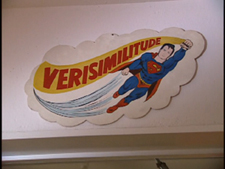 Disc Three: "Superman" Bonus Material
Disc Three: "Superman" Bonus MaterialSpeaking of carry-over, the rest of the extras from that disc appear here, on Disc Three - so there's no reason to hold on to your old copy. The three-part documentary hosted by Marc McClure returns here: "Taking Flight: The Development of a Saga" (30:14), "Making Superman: Filming the Legend" (30:40), and "The Magic Behind the Cape" (23:43) offers a detailed history of the film's creation. These featurettes include the last time we'd get to see Christopher Reeve discussing his most important film role.
A set of screen tests for Superman, Lois Lane, and Ursa offer a peek into what "Superman" might have been. These are hosted by Lynn Stalmaster, the movie's casting director, who also provides optional commentary on the Lois Lane tests.
The restored scenes (14:31 total) allow you to watch the bits that were edited back into the expanded edition (plus two more that were fully restored but were later rejected) separate from the movie itself.
For Williams fans, the collection of 35-plus minutes of unused and alternate music cues is a wonderful treat - but beware the "pop version" of "Can You Read My Mind," complete with Margot Kidder's spoken word performance. Like, groovy.
The documentaries and screen tests are presented in 1.33:1 full frame (with clips from the film properly letterboxed), while the restored scenes are given the same slick anamorphic widescreen treatment they received as part of the movie on Disc Two.
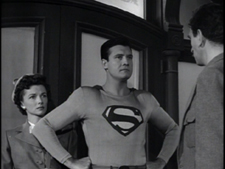 Disc Four: "Superman" Bonus Material continued
Disc Four: "Superman" Bonus Material continuedWith the extras from the 2001 disc all used up, what else could there possibly be? Well, how does a vintage television special strike you? "The Making of Superman" (51:46) is a promotional piece mixing behind-the-scenes footage with plenty of interviews. It's a wonderful archival piece that helps complete the making-of information in this set.
At the start of this review, I mentioned a sixth bonus movie. That would be "Superman and the Mole Men," the 1951 feature starring George Reeves as Superman and Phyllis Coates as Lois Lane. The movie acted as a large-scale pilot episode of sorts for the "Adventures of Superman" TV series. As such, it has already appeared on disc as a bonus feature on the DVD box set of that show's first season. It's nice to see it again here, though (even if there are no chapter stops, a minor grumble). It's a thrilling, intelligent bit of friendly-aliens-met-with-distrust-by-us-humans science fiction, and a nice launching point for the series. The transfer is impressive, crisp and clean, making the best of the low budget black-and-white photography.
For even more old school Superman, we get the first nine Superman cartoon shorts from Max and Dave Fleischer: "Superman," "The Mechanical Monsters," Billion Dollar Limited," "The Arctic Giant," "The Bulleteers," "The Magnetic Telescope," "Electric Earthquake," "Volcano," and "Terror on the Midway." These cartoons from the early 1940s are a milestone in animation and remain as thrilling as ever. Fans have seen these cartoons look pretty shabby in other releases (thanks to the shorts' public domain status); here, they've been cleaned up nicely, although some dirt, grain, and print scratches remain. I'd say they look better than they've ever looked on home video, and that includes the well-regarded "Diamond Anniversary Edition" release from Bosko.
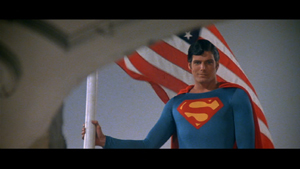 Disc Five: "Superman II" Original Theatrical Version
Disc Five: "Superman II" Original Theatrical Version"Come to me, son of Jor-El! Kneel before Zod!!"
The successes of "Superman II" come despite a series of mishaps and personnel switches that would have sabotaged a less lucky production. The movie was originally filmed simultaneously with "Superman" by director Richard Donner, although work on the sequel was eventually postponed in order for the filmmakers to focus more on the first picture. When filming finally resumed in 1979, Richard Lester, the director of such varied classics as "A Hard Day's Night" and "The Three Musketeers," was called in to take over for a disgruntled Donner. Lester reshot a few scenes and added some broader comic touches (and worked around an absent Marlon Brando, who was bumped from the project following money issues, and a no-show Gene Hackman, who refused to reshoot with a new director), and the final product is a movie credited to one director but in reality the work of two individuals with two separate visions. It's like two movies edited into one.
So how did "Superman II" get so good despite itself? Well, for starters, the "vision" wasn't too diverse; Lester served on the first movie as something of a go-between for Donner and executive producer Alexander Salkind, so he knew the ropes of the franchise from the very beginning. Secondly, despite the various rewrites that occurred as production resumed on the sequel, those rewrites were done by David and Leslie Newman, who also worked on the original picture and therefore had a feel for the characters and action.
But above all, the basic story - originated by Mario Puzo as part of one epic work - kicks so much ass that it kind of saves itself. Consider the plot: three Kryptonian villains arrive on Earth and tear the joint up, just after Supes gives up his powers to be with Lois Lane! That's just great stuff, people.
We get all the great comic adventure flourishes, from a nail-biting opener involving a hydrogen bomb and the Eiffel Tower to the sort of supervillain rumbles we've come to love from the comic books to the glorious showdown at the Fortress of Solitude (!) that lets the Man of Steel unleash every trick in his superpower bag.
The movie's best assets are its baddies, including one of the all-time greats, General Zod. Played by Terence Stamp with scenery-chewing gusto, the obsessive, sinister Zod (a general of what, exactly?) becomes Superman's greatest cinematic foe, outshining even Hackman's Luthor (here appearing more as comic relief, but what a delicious role!). The screen crackles every time Stamp appears; his commanding presence defines the character as the guy who honestly deserves a shot at defeating the Man of Tomorrow.
Along with his cohorts - the devilishly sexy Ursa (Sarah Douglas) and the silent hulk Non (Jack O'Halloran) - Zod's challenge to Superman results in arguably the finest moment in the franchise: the Metropolis street brawl. Buses and cars are tossed around like paperweights. People get hurled through brick walls. Insurance claims go through the roof.
And Superman's grand entrance! "General, would you care to step outside?" I've seen this movie a good hundred-plus times, and I still want to cheer at that moment. Here's a movie that, like its predecessor, gets Superman. The aw-shucks sincerity, the cornball patriotism, the knowledge that it's OK to be cynicism-free, the sly, arrogant bombast. (Credit this to Donner, who understood how to interpret the story as American myth, not just as some campy comic book movie.)
What we also get in "Superman II" is a depth of character often absent in sequels of this sort. In between the Zod plotline, we get Lois Lane finally discovering the truth about Clark Kent. You know, why he's always disappearing whenever Superman shows up. The first movie showcased a brilliant performance by Reeve, who had to balance the grandeur of the superhero with the slouchy nerdishness of his alter ego, managing to switch characters with just a minor adjustment in posture. He does the same here, and it's still a fabulous acting trick. But this time it pays off: with his character finally getting to properly admit his love for Lois (played again by Kidder) as well as question whether or not he can be a superhero and have a workable relationship (resulting in the heartbreaking decision to give up his powers), Reeve is allowed to do even more this second time around. For a genre that's often skimpy on characterization and attention to performance, "Superman II" is such a welcome change of pace.
If the first two Superman movies are nothing else, they're grand entertainments. These are movies that make us cheer, make us smile. We're thrilled, wowed, engaged, won over. It's epic mythmaking with a human touch and a great comic sense, storytelling with wit and verve and nonstop magic. It's hard for me to pick a favorite of the two; I prefer the first one's vision of neo-Biblical epic, and the second's juggling of grandiose action and intimate drama.
Watching Reeve's Superman stand behind that waving flag as he addresses a grateful president, I recognized once again that this character - and these films - are perfect Americana. Bold, brash storytelling. Larger than life bravado, triumph over tyranny. Superman, apple pie. Truth, justice, and the American way. "Superman II" made me cheer when I was seven years old, and it'll make me cheer when I'm ninety.
Way to go, Superman! What a nice man.
Video & Audio
As with "Superman I," the transfer (again in 2.35:1 anamorphic widescreen) here is wonderful, with only the faintest bit of grain showing the film's age. The remixed 5.1 soundtrack is fantastic, while purists will enjoy the original stereo mix. Again, a stereo French dub is offered along with optional subtitles in English, French, and Spanish.
Note: Sadly, Warner Bros. has replaced the 1981-era opening logo with its new studio logo. It's a quibble, sure, but I always cringe when a studio does that to its library titles.
Extras
No word from Richard Lester - it's Salkind and Spengler who provide another commentary. Salkind keeps talking about himself and, more importantly, how his decisions behind the scenes were for the best. It's a bit overly defensive.
The lone deleted scene is something called "Superman's Soufflé" (40 sec.), in which, well, Superman tries to bake a soufflé with his heat vision. I'm glad it was cut, too, especially considering the lameness of the opening gag (we think Superman is talking about sex, but it's just baking, ha ha). Presented in non-anamorphic widescreen.
The film's theatrical trailer (2:31) is action-packed and designed to widen the eyes of kids everywhere. (And it's in anamorphic widescreen!)
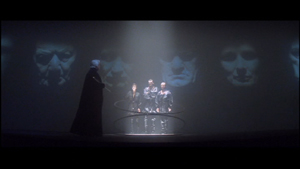 Disc Six: "Superman II: The Richard Donner Cut"
Disc Six: "Superman II: The Richard Donner Cut"The story behind "Superman II" was widely known among fans, but it wasn't until the internet age when those same fans truly started to demand to see the film as Donner would've made it. Abandoned footage, which had made its way into bootleg circles over the years, was now finding itself in the hands of would-be editors who were constructing their own versions of the film, working off of easy-to-obtain copies of the original working screenplay. Other fans, not satisfied with those bootleg versions, began shouting at Warner Brothers, begging them to release whatever they could of the original, pre-Lester "Superman II."
Thus began "Superman II: The Richard Donner Cut." It's a bold task: locate every inch of the original prints of Donner's unused footage, restore it to a usable quality, and start piecing together the closest thing possible to what Donner would have released had he not been fired by the Salkinds. Donner would work closely with editor Michael Thau, who also worked on the restoration of the "Superman" expanded edition.
So what's it like to finally see one of the great unseen movies in cinema history, a once-forbidden what-if project on par with Orson Welles' original cut of "The Magnificent Ambersons?" It's pretty darn nice - provided you can keep it in your head that this is a rough sketch of a movie and not a final, perfect version of Donner's original concepts.
The main problem is that many scenes Donner intended to film were never shot at all, meaning that for one key scene, footage from a screen test between Christopher Reeve and Margot Kidder had to be used. The footage is out of place - the hotel room isn't the same as we saw in previous scenes, Clark's glasses are a different design, and the acting from both isn't as polished as what would appear during regular filming. The absence of some scenes means there are plenty of plot holes throughout, as the connecting bits between how this character got from here to there were not available for this restoration. (Some of these holes are patched by Donner reluctantly using footage shot by Richard Lester for the theatrical "Superman II.") Meanwhile, several key effects are either unfinished or, in an attempt to avoid using any technology not around from 1976-81, come off as very dodgy.
The biggest dilemma involves the movie's finale. (OK, so there will be spoilers here, but I'm guessing that if you're interested in this title, you're quite familiar with the original versions of both "Superman I" and "II," and so nothing said here will actually ruin anything for you.) "Superman II" was originally supposed to end with the hero reversing the planet's rotation and turning back time. But when the producers got nervous about the original cliffhanger ending for "Superman I," they asked Donner to move the time-travel climax to that movie instead. Donner and creative consultant Tom Mankiewicz figured they could think up a new ending when work on the second movie resumed. Alas, for them it never did, and so for this restoration, Donner had only two options: keep the ending from the theatrical version (and use all of Lester's footage), or do the same world-turns-back ending again (and repeat a plot point many today deem questionable - although I admire its silliness). As it is, the gimmick works best in "Superman I," due to its emotional charge. But there's a bit of a smile on Superman's face in this version as he does his trick, and the context could be a bit of the old "well, here we go again," which adds in some fun.
So what else is different? The entire opening, for starters. The complete Eiffel Tower sequence (an addition for the re-written Lester version) is gone, replaced by a new reason for the villain's escape from the Phantom Zone. Lois becoming convinced that Clark is Superman gets bumped up to the early Metropolis scenes, complete with a different, more thrilling death-defying attempt to prove her point. (A bit of early banter between the two is so expertly acted that it's a crime to not see it used in Lester's version.) Most of the middle of the film is what we've already seen - Niagra Falls, the baddies arrival on Earth - with a few alternate scenes here and there, some extra moments of the villains, a little more Lex Luthor, and, most importantly, the return of Marlon Brando, who filmed footage for "Superman II" but was replaced by Susannah York in the theatrical release when the Salkinds balked at Brando's salary. The ending follows the same massive battle (with a few key additions), then adds in a vital Clark-Lois moment, which kicks off a completely new finale. Overall, the action and drama are amped up and the comedy is toned down (as evident in even the smallest of tweaks here and there).
As a replacement of the theatrical version, this new edition doesn't quite work. It's just too rough, too clumsy, too problematic as an actual movie. But as a curiosity, it's genius. Here we get to see footage that would have otherwise remained lost forever, footage that, in many cases, is better than anything in the Lester version. We get a glimpse of what might have been, and our imagination can fill in the gaps.
Video & Audio
As the "Donner Cut" was culled from multiple sources, the image quality isn't as consistent as an ordinary movie. But even at its worst (namely, the screen test footage and a few weak effects shots), it still looks pretty good. Everything's been restored as well as possible, with plenty of the footage matching the high quality of the theatrical version. Presented in anamorphic 2.35:1 widescreen.
Extras
The disc kicks off with an introduction from Richard Donner (1:54), who seems pleased as punch to finally be seeing his own version of the movie. Notice how he never mentions Lester by name, instead calling him "another director."
Donner continues his discussion in a commentary track shared by Tom Mankiewicz. As with their chat on the "Superman" expanded edition, they're quite lively here, sharing plenty of colorful anecdotes and generally shooting the breeze like the old friends they are.
"Superman II: Restoring the Vision" (13:18) is a brief but exceptional look at the movie's complex history and the heavy work that went into answering the fans' call for this new edit. Donner, Mankiewicz, and Thau explain their reasoning behind many of the changes, from the big stuff to minor, almost unnoticeable alterations such as the use of alternate camera angles in certain shots. There's plenty badmouthing of Lester all around, which is a bit much, considering just how wonderfully his own version turned out. (Disappointingly yet understandably, Lester declined to appear in any bonus material for this entire set; we only see him in archival footage.)
The deleted scenes (8:43) are smallish bits that didn't quite fit into Donner's edit, mostly throwaway comedy bits that add little to the final product. These scenes haven't been fully restored and therefore look and sound a little rough.
In a nice touch, all the bonus material is presented in anamorphic widescreen (1.78:1, with movie footage being shown at the original 2.35:1).
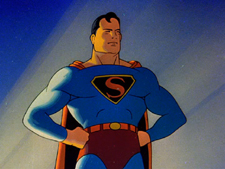 Disc Seven: "Superman II" Bonus Material
Disc Seven: "Superman II" Bonus Material"The Making of Superman II" (52:11) is another vintage TV special, mixing promotional fluff with valuable interviews with cast and crew. Talk of the chaos behind the scenes is avoided, the focus instead being on the stunts and effects and on the series' popularity.
Another vintage TV special, 1988's "Superman 50th Anniversary" (48:07), is a peculiar beast: hosted by Dana Carvey and featuring Fred Willard as the deputy mayor of Metropolis, Paul Dooley as the editor of a rival Metropolis newspaper, and Franken & Davis as bottom-rung crimefighters The Awesome Pair, the show is more comedy than birthday celebration. It's cute in spurts, at times very funny, but it can't hold the joke for the full hour.
"First Flight: The Fleischer Superman Series" (12:54) examines the history and impact of the Fleischer cartoons, allowing for further appreciation of a terrific chunk of animation.
It's the remainder of the Fleischer cartoons that round out this disc. Here, we get the eight shorts the Fleischers made after starting up Famous Studios: "Japoteurs," "Showdown," "Eleventh Hour," "Destruction, Inc.," "The Mummy Strikes," "Jungle Drums," "The Underground World," and "Secret Agent." These are considered the "lesser" batch of the series, as they were made on a tighter budget and ditch much of the science fantasy elements of the earlier cartoons, but they still thrill all the same. As with the shorts seen on Disc Four, we get dirt, scratches, and grain, yet still wind up with a much cleaner image than has ever appeared on disc before.
All features on this disc are presented in their original 1.33:1 full frame format. The TV specials haven't aged well.
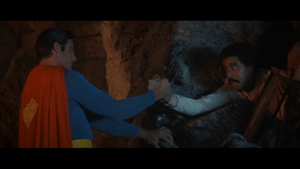 Disc Eight: "Superman III"
Disc Eight: "Superman III""I ask you to kill Superman, and you're telling me you couldn't even do that one simple thing."
It's "Superman III" that many feel brought about the end of a good thing. I say no, that honor goes to "Superman IV: The Quest For Peace," for "Superman III," despite its total goofiness, is still a hit. Yes, really.
The story follows Clark (Reeve, who else?) as he returns to Smallville for a high school reunion. He runs into Lana Lang (Annette O'Toole), and the opportunity for romance is about to present itself. Of course, some major bad guys have to stand in the way, so we get Robert Vaughn as a millionaire hiring computer whiz Richard Pryor to sabotage a weather satellite into working for his favor. Toss in a giant evil supercomputer and some fake Kryptonite, and you're set for some sheer silly fun.
I admit, there's a lot of stuff here that might come off as, well, stupid. The climactic battle with the supercomputer is complete nonsense, and that whole storyline doesn't really click with the rest of the film. Richard Pryor's appearance also put some folks off, with his comic relief being too ridiculous (as if an evil supercomputer is serious business).
But there are a few truly great Superman moments hiding here, moments that often get overlooked when discussing the high points of the franchise. For starters, we get a pointless yet very cool scene in which Supes puts out an industrial fire by freezing a lake. Then there's the reunion scene, which has a surprising amount of heart; Reeve proves again why his take on Supes isn't just when he's the hero, but how he plays uber-nerd Kent. (Another bit on the old Kent farm hits the point home.) And the opening bits featuring Pryor actually are funny stuff, with a sneaky scheme so cool it got a mention in "Office Space."
The best segment of the film, however, is the accidental side effects of Pryor's fake Kryptonite: it turns Supes evil. His evil deeds are corny stuff, such as blowing out the Olympic torch and straightening the Pisa tower (I'll agree to the lameness of these scenes, yet I laugh anyway). But it still works. Because finally, the big guy's split in two, with good Clark Kent facing off against evil Superman in a powerhouse of a fight, and man, what a great scene, with Reeve chewing every last bit of scenery he can find.
Perhaps the sneakiest moment in the entire "Superman" series comes at the beginning of "Superman III." Unlike the other films, which use grand openings to announce themselves as "event" pictures, "Superman III" starts very small - in a Metropolis unemployment office. If you're not paying attention, you might miss the mentions of the fictional city, forcing you to figure out which Richard Pryor movie this is. Only after a few minutes of light comedy do the opening credits begin. It's a great change, and while it may lack the punch of that gigantic John Williams score, it sets the pace for what will be a different kind of Superman flick.
For all its flaws, "Superman III" still entertains me with every viewing. Any chance to see Richard Pryor in an oversized cowboy hat or Clark Kent finally get to be the big man in Smallville is aces in my book. It's a great addition to the legacy that is the Man of Steel.
Video & Audio
The anamorphic widescreen (2.35:1) presentation here is a bit soft (due to the age and lowered budget of the film) but otherwise just swell, as Clark might say. The original stereo soundtrack comes across as sparkling. Also included are a French stereo dub and optional English, French, and Spanish subtitles.
Extras
Yet another commentary from Salkind and Spengler, which sounds pasted together from separate chats and is once again quite bland. Salkind has a penchant for droning on and on in monotone run-on sentences, mostly while talking about himself. If you can sit through it, you'll find a few fun facts, but it's a tough go.
More interesting is the 49-minute "Making of Superman III," a vintage television special (yes, another one) that, when not overdoing the self-promotion, offers up plenty of nifty behind-the-scenes shots and some wonderful interview moments with the stars. Presented in its original full screen format, with clips from the film (unfortunately) cropped accordingly.
19 minutes of deleted and alternate scenes include some extra fun Pryor bits and a few clever yet understandably unnecessary side moments. These clips have seen better days - their visual iffiness is lessened even more by being mere pan-and-scan offerings (possibly the only condition in which they were available).
The overlong, gives-away-way-too-much theatrical trailer rounds out this disc; it's presented in anamorphic 1.78:1 and looks decent enough.
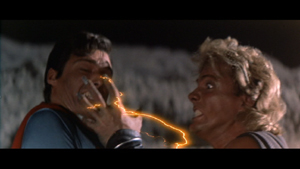 Disc Nine: "Superman IV: The Quest For Peace"
Disc Nine: "Superman IV: The Quest For Peace""Destroy! Destroy Superman now!!"
If you're wondering how the "Superman" movie franchise could have gone so horribly, tragically wrong as to give us "Superman IV: The Quest For Peace," all you really need to know is that after "Superman III" left theaters, the rights for the series were soon bought out by none other than Menahem Golan and Yoram Globus. You remember those guys, the company responsible for Cannon Films. The guys who made "Delta Force," "Firewalker," and "Alien From L.A.," just to name a few.
Once they got their grubby hands on Supes, all bets were off. The special effects budget seemed to be a mere fraction of the original's, right down to the opening credits, which look like a pale, cartoony imitation of the now-classic "flying names" montage of the earlier films. The screenplay is laughable, the action pathetic, and somehow, everyone forgot how to act.
Speaking of Reeve, he gets credit for co-writing the story (along with screenwriters Lawrence Konner and Mark Rosenthal), and he's to blame for the loopy premise in which Supes takes it upon himself to rid the planet of nuclear missiles. You see, some kid thinks the best way to end the Cold War was to ask Superman to disarm everybody, and the Man of Steel, breaking his vow to stay out of such political matters, is eager to oblige.
I don't know why Superman would only concentrate on nukes and not other forms of weapons, and I don't know why getting rid of nukes would be the single thing that would end all conflict on the planet, and I don't know why, when Supes addresses the United Nations, everyone cheers when he announces his plan. Aren't these the same governments that refused to disarm the day before? My brain hurts.
Fortunately, we have criminal mastermind Lex Luthor (Hackman, returning to the series), who's recently busted out of prison with the help of his moronic nephew Lenny (Jon Cryer, in his single greatest career embarrassment). Lenny's job is to be an idiot; his dialogue consists of two alternating phrases: "Like, oh, wow" and "It's the Dude of Steel!"
Lex steals a strand of Superman's hair and uses its DNA to create a solar-powered supervillain named Nuclear Man (Mark Pillow). Nuclear Man has Luthor's voice and obeys Luthor's commands, but he also wants to punch a lot of stuff, and that makes him dangerous. He also looks like he's always trying to squeeze a fart that just won't come out, which makes him look slightly less dangerous.
There's a subplot involving the Daily Planet being bought out by a tabloid magnate (Sam Wanamaker), who turns the paper into a sleaze rag. The new boss has a daughter, Lacy (Mariel Hemingway), who takes a liking to Clark Kent. This is the set-up for a wacky double date between Lacy and Clark and Lois Lane (Kidder, as always) and Superman. Can Supes juggle two women at once? Fear not: the result is a scene worthy of Greg Brady, or maybe Jack Tripper.
The story just keeps chugging along, wrapping up with a fight on an old "Star Trek" set that I think was supposed to be the moon. Styrofoam rocks are hurled, punches are thrown, viewers are lulled into a nice, deep sleep. At one point in the film, Lex calls his nephew "the Dutch Elm Disease of my family tree." The description is equally fitting this movie, a sad final chapter in an otherwise brilliant movie franchise. That this movie is how the Reeve-era "Superman" movie legacy ended would be a depressing thought if the movie weren't so endlessly hilarious.
Video & Audio
Again, more budget slashing results in a weaker-looking movie, and it shows here. The anamorphic widescreen (2.35:1) transfer is good but not great, due quite possibly to the shoddiness of the source itself. The soundtrack is the original Dolby stereo, with a French stereo dub included, along with optional subtitles in English, French, and Spanish.
Extras
No Salkind and Spengler here - this time, it's screenwriter Mark Rosenthal doing the commentary work, and what a joy this track is. His very first words are all about how horribly wrong the movie is. From the idiocy at Cannon to the idiocy of the cutting of the movie by some 45 minutes (thus making the story, in Rosenthal's words, "incomprehensible") to the idiocy of everything else, Rosenthal is quite honest. There are some gaps in between all that complaining, but hey, would you want to talk about "Superman IV" for that long? Me neither.
31 of those 45 deleted minutes appear here, for those wondering what a scene has to do to be cut from a movie this awful. (Contrary to popular belief, the restoration of this movie to its original epic running time would not improve a darn thing.) The footage is in terrible shape - scratchy, dirty, and with most effects unfinished.
The theatrical trailer (1:26) is lousy enough to give moviegoers plenty of advance warning to avoid the film at all costs.
The trailer and all deleted scenes are presented in 2.35:1 anamorphic widescreen.
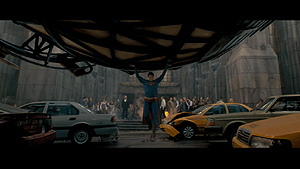 Disc Ten: "Superman Returns"
Disc Ten: "Superman Returns""But millions of people will die."
"BILLIONS!! Once again, the press underestimates me."
You know how when you watch Christopher Reeve all done up in the red and blue outfit, standing there in confidence, you pause in awe as you think to yourself, "Without a single doubt in the world, that's Superman?" Other guys may have dressed up in the suit, but only Reeve was one hundred percent convincing. Looking at Brandon Routh in "Superman Returns," that feeling comes back. Without a single doubt in the world, one hundred percent convincing, this guy is Superman.
That's a pretty hefty statement to make, but "Superman Returns" deserves nothing but hefty statements - it's an absolute marvel of a film, a comic book blockbuster that gets everything right. And that everything starts with the casting of Routh, who looked so miscast in those early publicity shots yet proves to us all that, like Reeve before him, he's the only one for the role. He even cribs a little from his predecessor: his Clark Kent mannerisms show a glimmer of Reeve's bumbling nerd, while his Superman is as gosh-darn honest as Reeve ever was. (Consider the scene in which Superman, after he's just stopped an airplane from crashing into downtown Metropolis, steps aboard and reassures the rescued passengers about the general safety of air travel. With this one corny speech, Routh tells the world, "I am Superman.")
Despite using Reeve's performance as a launching point, Routh makes the character all his own. He brings a desperate loneliness to the role, a tender sadness that highlights this film's most surprising (and most refreshing) aspect: its emotional depth. This is a Superman movie about just how alone Superman is in our world. He's an alien, the last of his kind. There is no one on Earth like him, no one with whom to chat about shared experiences. (There are no other superheroes in this universe. Superman gets no help in saving the day, and the next day, and the next.) And yet he is never alone - he hears everything, all those cries for help, a fact which only makes his isolation all the worse.
Screenwriters Michael Dougherty and Dan Harris (who was joined in the story development stage by director Bryan Singer) up the ante by giving us a story in which Superman has left Earth in search of remnants of Krypton. He found none, and the movie begins with his return to his adopted home. His five-year absence left the world wondering, and it tore apart a few vital relationships, most notably the one with Lois Lane (Kate Bosworth), who has since moved on, landed a fiancé (Jason Marsden), penned an editorial titled "Why the World Doesn't Need Superman," and become a mother. This is a pretty risky move for what might have otherwise been a safe summer movie bet - why not just retell the origin story, or whip up some generic adventure? Dougherty and Harris, who brought a strikingly human angle to Singer's "X2," are not content with telling just another popcorn spectacle. They want to get to the more intimate side of the Superman myth.
And boy, do they ever. This is a comic book tale where the characters get to be three-dimensional. Not only our hero, but Lois, too. There's a wonderful moment that parallels the balcony interview scene from the 1978 "Superman" - the one that plays out like a first date for DC Comics' most famous couple, ending with that romantic flight over the city - only here, it's a matter of heartbreak for our heroine. Superman never said goodbye, and Lois was left wondering. And now, he returns to her on the roof of the Daily Planet, another late night visit. In this scene, "Superman" as a movie franchise grows up, having to now deal with the pain and confusion of such complicated adult circumstances. Bosworth has never really impressed me before, but here, she shines, revealing a woman torn.
Making things all the more thorny: Richard, the fiancé, is no schlep of a Baxter, but a genuine hero himself, an ace pilot who soars into action, much like the Man of Steel, when danger calls. History tells us to root for Lois and Clark, but there is much hope in Lois and Richard. More so, even, if you consider that Richard does his derring-do without the benefit of alien superpowers. Heck, he even gets to rescue Superman in one scene. In this respect, "Superman Returns" becomes a story about the heroic potential in us all, a theme highlighted by the use of a critical quote from the Reeve-era "Superman" films, in which Superman's father, Jor-El, left behind this message:
"They can be a great people, Kal-El. They wish to be. They only lack the light to show the way. For this reason above all, their capacity for good, I have sent them you, my only son."
Forget for a moment the Biblical (both Old and New Testament) undertones of the Superman mythology and how it's played up in that snippet of dialogue. Focus instead on the heart of such a phrase. "Superman Returns" is, underneath all its heartache and lonesomeness, a most optimistic movie.
That quotation, by the way, brings up a vital issue. In crafting this film, Singer envisioned a companion movie to the early Reeve films. It's not exactly a sequel to "Superman" and "Superman II," but instead it can be viewed as a sequel to the spirit of those films. We get character profiles more in line with what audiences saw in 1978 instead of what's been changed since (archvillain Lex Luthor - here deliciously played with a genius combination of humor and menace, by a perfectly cast Kevin Spacey - is back to being a crook instead of a powerful billionaire; Lois still can't spell worth spit; etc.), we get John Williams' epic themes (my vote for the most perfect piece of movie music ever crafted) returning in grand style, and yes, we even get Marlon Brando himself digitally returning from the grave to reprise his role as Jor-El.
All of this sounds on the surface like a cheat, as if Singer and company are too unsure of themselves to craft a new series, so they instead jump on the cape of the well-loved Reeve films. I, for one, was positive during all the pre-release hype that this was a colossally awful idea. Then I saw the movie, and discovered that Singer is most certainly not piggybacking on previous successes, nor is he merely softballing his way through his job. He has, instead, made a movie that is reverent of the Superman mythos - all of it, not just the Reeve era, as evident by countless other references and a few key cameos - all the while never being afraid to push the characters forward. It's moving ahead while keeping one eye on the past.
Plus, it's just so much fun to see the classic "flying text" opening credits over Williams' theme one more time on the big screen. Which brings me to my next point, lest you think I was about to overlook the main reason most of you are wanting to see "Superman Returns:" this is one heck of a good time. Don't let all my talk about emotions and character development and personal what-not fool you. Singer's a master at staging breathtaking action, and "Superman Returns" delivers the thrills in spades. The action set pieces are flawlessly constructed to provide maximum visceral experience, so much that I felt myself so wound up by the airplane rescue sequence that I was aching to cheer when it finished - and I found myself in tears after being exhausted by a barrage of heroic rescues, relief only coming when one character gets saved from certain death, and in doing so, muttering a line that's a valentine to any lifelong Superman fan. (A great moment in a movie loaded with great moments.)
The action is, in a word, big. The whole movie is big, a two-and-a-half hour epic combining drama and comedy and romance and action, action, action. Scenes here recall the larger-than-life spectacle of the 1978 film, updated with utterly believable CGI effects. Reeve convinced me a man can fly, but Routh, aided by the technology of the 21st Century, convinces me a man can not only fly, but fly through massive fireballs at speeds beyond human comprehension.
You may have noticed I have not discussed something important: the plot. Sure, I mentioned the general idea of Superman returning and causing issues with Lois, but I have intentionally left out everything else. This is not because I want to keep secrets from you. It is because what "Superman Returns" is about is not really what "Superman Returns" is about, if you follow me. There's so much more to this movie than the story outline. Granted, the story is as exciting as can be (side note: some might complain that Lex Luthor's master plan is preposterous, but hey, all of Lex Luthor's plans are inherently preposterous; it's not what he does, but how he does it, and here, he does it wonderfully), but this is a movie that ultimately depends on the internal, not the external. The plot exists to bring us closer to the characters, not just to give the effects crew something to do. This is that rare summer blockbuster that breathes.
It is, if we want to return once more to hefty statements, exactly what we all want our popcorn movies to be. Not the dumbed-down adventures that aspire only to a big opening weekend and some DVD sales, but something more, something that respects intelligence, something that aims to move us with well-crafted characters and precise storytelling. Last year's "Batman Begins" set the bar so very high for comic book movies, and that after a series of impressive, well-received character-driven efforts that include "X-Men" and "Spider-Man 2." Now comes "Superman Returns," which shatters that bar. This is a truly spectacular experience, unquestionably worthy of the 1978 "Superman." "Superman Returns" joins that predecessor on the short list of all-time great superhero films, but it is more than just a great superhero movie. It is a great movie of any kind. Singer officially becomes one of the very best filmmakers working today; Dougherty and Harris announce themselves as storytellers of the highest order; and Routh?
Why, he's Superman. Not a single doubt in the world.
Video & Audio
Of course this is going to be the best-looking in the box, but still: wow. The anamorphic widescreen (2.35:1) transfer is downright gorgeous, crisp and lush, perfectly capturing Newton Thomas Sigel's digital cinematography. The soundtrack comes in Dolby 5.1, and it, too, is outstanding, as expected. A Spanish 5.1 track is also offered, as are optional subtitles in English, French, and Spanish.
Extras
None on this disc. It's been said that Bryan Singer isn't fond of doing commentaries so soon after finishing a movie, so expect a possible double dip a few years down the road. That said, the extras that appear on the next disc are more than enough to make up for things.
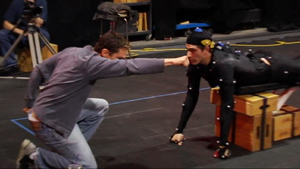 Disc Eleven: "Superman Returns" Bonus Material
Disc Eleven: "Superman Returns" Bonus MaterialGreat Caesar's Ghost! Running a massive two hours fifty-three minutes (!), the documentary "Requiem for Krypton: Making Superman Returns" is more behind-the-scenes goodness than any fan could ever need, and that's a good thing. It details everything about the movie, from Singer's first work on the film (before he actually signed on to direct the thing) to the last day of shooting, with you-are-there clarity. It's one of the best making-of bonus features I've ever seen.
When you're finally done with that, you can move on to "Resurrecting Jor-El" (3:59), a detailed glimpse of how Brando's footage was digitally manipulated to fit just a few words from the new screenplay. It's set to a funky dance beat and plays like a music video. Weird and wonderful.
Eleven deleted scenes (14:44 total) are minor cuts, mostly involving the film's first act - more of Martha Kent and a bit of Clark on the farm. Although effects have not been completed (we still see the wires holding up the young Clark while he learns to fly), music has been added, which plays well.
All of the extras listed above include optional French subtitles.
The film's teaser trailer and theatrical trailer are included, as are promos for the "Christopher Reeve Collection" and two DC Comics video games. An obnoxious trailer for the obnoxious "Lady in the Water" plays as you load the disc. Luckily, you can skip past it.
"Requiem," the deleted scenes, and the movie's trailers are in anamorphic widescreen; "Jor-El" is in full screen; the other promo bits are in non-anamorphic widescreen.
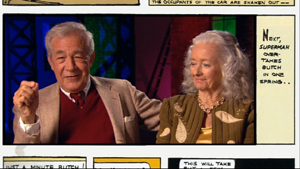 Disc Twelve: "Look! Up in the Sky! The Amazing Story of Superman"
Disc Twelve: "Look! Up in the Sky! The Amazing Story of Superman"I reviewed the original release of "Look! Up in the Sky!" for DVD Talk earlier this year; the disc in this set is identical to the previous release. Here are the highlights of that review:
"Look, Up In the Sky! The Amazing Story of Superman" is very much a commercial for "Superman Returns" - as well as "Smallville," which continues to be a money-maker for Warner Brothers as well - but at least the filmmakers are kind enough to hold off on the sales pitch until the end. Director Kevin Burns (the chap behind the long-form making-of docs found on the DVDs for "Star Wars," "Planet of the Apes," and "Cleopatra") could have gone the tackier route, the kind we've seen too often before, the kind where one star guides us on a tour of the set of the New Hit Movie, interviews his/her co-stars, introduces clips, and oh, by the way, would you like to see the long history of this franchise boiled down to a few minutes of cheap montage?
In fact, Burns goes the completely opposite route (although he does bring us Kevin Spacey, star of the New Hit Movie, for narration duties); in just under two hours, he and his crew offer up the most complete history of the character I've ever seen. We get it all in extreme detail, from Shuster and Siegel's original "Super-Man" short story (the name was used to define an evil psychic) to long discussions on George Reeves and Christopher Reeve to DC Comics' ups and downs with the character on the comics page. For the newcomer, you get a detailed examination of the Man of Steel's many changes over the decades; for the hardcore Supes fanatic, you get ultra-rare clips of the 1950s "Superboy," "Superpup" (in which little people wore dog costumes!), and the infamous musical comedy "It's a Bird! It's a Plane! It's Superman!," seen here in a television adaptation starring David Wilson, who could not dance, as a dancing Superman.
"Look, Up In the Sky!" works best in its first hour, when time is spent detailing the history of the comics, radio shows, cartoon shorts, serial, movie ("Superman and the Mole Men"), and TV series - perhaps because by the time we turn our attention to the 1978 film "Superman," we've seen a lot of this stuff before, either in previous documentaries or as DVD bonus features, unlike the earlier projects, whose behind-the-scenes shenanigans have remained relatively unseen. When the movie spends plenty of time on the Reeve era, one gets the feeling that Burns is holding back, perhaps not wanting this portion of the timeline (with its ample archival material) to overshadow the rest of the story, perhaps not to repeat too much of what's already been seen elsewhere, or perhaps to leave a little something for the supplemental sections of the forthcoming deluxe DVD releases.
Video & Audio
"Look! Up in the Sky" comes in 1.78:1 widescreen (with anamorphic enhancement). All footage from projects not filmed in this ratio have been cropped, either on the sides (the movies) or tops and bottoms (the earlier TV shows). This is a nuisance, but these were not meant to be reference shots, so it's understandable. (Only once is the cropping noticeable, and that's in a tightly composed scene from the 1978 film.)
As this is a documentary using a variety of archival footage going back some eighty years, the video quality has quite a range, depending on the age and ownership of the material. The brand new interviews look quite sharp, if you'd prefer that as an indicator of what to expect.
The Dolby 5.1 surround mix makes playful use of all speakers when "swooshing" flying sounds come and go. And, of course, John Williams' masterful themes remain a treat for the ears. Optional French subtitles are provided.
Extras
None, except for the batch of Warner Bros. trailers that plays as you load the disc. This is a direct copy of the title's single-disc release from earlier this year. The Bryan Singer video journals that appeared as bonus material on the film's limited two-disc release are available in this set on Disc Fourteen.
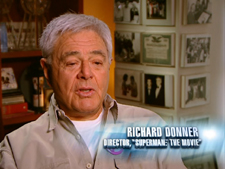 Disc Thirteen: "You Will Believe: The Making of a Saga"
Disc Thirteen: "You Will Believe: The Making of a Saga"If the coverage of the Reeve-era movies in "Look! Up in the Sky" seemed a bit slight, maybe this is why: the 89-minute documentary "You Will Believe: The Cinematic Sage of Superman" details the history of the Christopher Reeve series in freakish detail, all without blandly rehashing information already presented on previous discs.
The documentary comes in five parts: "Origin," "Vision," "Ascent," "Crisis," and "Redemption" - although, strangely, "Redemption" covers the series' downfall in "Superman III" and "IV."
The filmmakers tend to skew toward Donner's side of the story, painting the Salkinds as meddlers and Lester as an interloper who ruined the series. (Again, the notion of "Superman II" being a great movie is ignored.) Despite the bias (which Ilya Salkind's appearance does nothing to fix, thanks to his enormous ego and hideous toupee), and despite everyone badmouthing "Superman III" (OK, I get it, everyone hates it, but can't I still love it anyway?), it's great to see so much honesty from all involved. With the pressures of the time so far behind them, the cast and crew openly discuss every bit of on-set tension and off-set questioning. (Best apologetic bit: Marc McClure explains that despite a general consensus that things were very wrong with "Superman III," everyone agreed to return for "IV" as a favor of sorts for Christopher Reeve, whom they hoped could salvage things.)
It's not all series-bashing, however. The film is loaded with wonderful anecdotes, most of them coming from Donner, who had some mighty strange experiences working with Brando, and from Terence Stamp, who parlayed his character's authority into on-set power, bossing around (and cussing out) his co-stars. Everyone involved has a nifty story to share, and their overall love for the experience is infectious.
"You Will Believe" is, simply, your first and last stop for info on Reeve-era Superman, vital viewing for anyone interested in the franchise.
Video & Audio
As with the other docs in this set, the video quality here varies based on source material. The new interviews are shot in digital video and look as sharp as the format allows; archival footage, meanwhile, looks from good to questionable to awful, depending. Presented in 1.33:1 full frame, with movie footage letterboxed. The stereo soundtrack does its job well. No subtitles or alternate audio tracks are provided.
Extras
"The Mythology of Superman" (19:32) presents interviews with scholars and comic book experts, all of them discussing how Superman fits within the mold of mythological storytelling. It's a clever "Power of Myth" breakdown of the character that treats the franchise with much respect.
"Heart of a Hero: A Tribute to Christopher Reeve" (17:59) is just what you think it is: a big, mushy, wonderful tip of the hat to Reeve's post-accident activism. Not that anybody needed convincing just how great a guy Reeve was, but it's still a lovely gesture and an informative feature for those unfamiliar with just how much he did despite his limitations.
From great to embarrassing: "The Adventures of Superpup" (21:32) is an unaired pilot for a failed kiddie TV series (in color!) in which little people dressed up in frightening, rubbery dog costumes and parodied the Superman franchise. Our hero's secret identity is Bark Bent. And a talking mouse puppet is his sidekick. Oh, the humanity. (For those daring enough to watch: there are no chapter stops, and the video has been cobbled together from various sources, meaning we go mid-show from washed-out color to ugly, rusty black-and-white.)
Three Warner cartoons give us parody of a much more enjoyable kind. Bugs Bunny is "Super Rabbit," Private Snafu is "Snafuperman," and Daffy Duck is "Stupor Duck." All are wonderful, although as the Snafu short was intended for wartime military use and not public consumption, perhaps an introduction should have been included to explain just why it was made.
Finally, we get a promo spot for "Superman: The Theatrical Serials Collection."
All extras here are presented in 1.33:1 full frame, again with movie clips properly letterboxed.
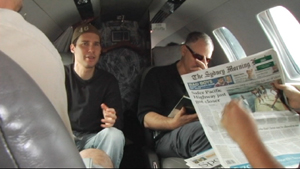 Disc Fourteen: "Bryan Singer's Video Journals"
Disc Fourteen: "Bryan Singer's Video Journals"Video journals documenting a film's creation, posted to the internet for rabid fan consumption, are now a vital part of promoting any big budget movie with heavy fanboy appeal. It's a way of letting the public feel a little closer to an upcoming blockbuster. Peter Jackson popularized the gimmick with his video diaries from the sets of "The Lord of the Rings" and "King Kong," and for "Superman Returns," Bryan Singer gave it a go.
Singer's "video blog" comes in 29 parts, with most entries clocking in at only a minute or two. It's mainly lighthearted fun mixed with up-close how-they-did-it madness, without giving too much of the story itself away.
The most amusing entries are quirky asides - Singer visits Jackson on the set of "Kong" (which becomes even more spectacular once you watch "Blog #28," featuring a visiting Frank Darabont); co-star Kal Penn becomes obsessed with the (quite dangerous) element krypton - while the behind-the-scenes moments have a you-are-there closeness that only a diary like this can provide.
Several of these journals were available on the two-disc "Look! Up in the Sky" release; this marks the first time all 29 entries have been released on DVD together.
Video & Audio
The journals get the anamorphic widescreen treatment here. I'm not sure if this is the original format (I never saw them online), as some of the on-screen text is cut off at the bottom of the screen. The digital video isn't movie-quality, considering its intent as an internet feature, but it's fine enough here for on-set diary purposes. For audio, the in-camera microphone was often used, resulting in a lack of clarity as wind and background noise sometimes got in the way.
Extras
Well, the diaries are the extras, really.
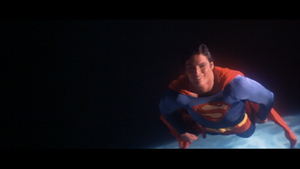 Final Thoughts
Final ThoughtsSo after all that, is there the slightest doubt in anyone's mind that this set belongs in the DVD Talk Collector Series? Of course not. This is a monumental collection, giving the fan every last bit of Superman cinema available in one knockout package. Each disc in this set stands out as a marvel on its own; as a whole, it's one of the best DVD collections ever produced. Get it, enjoy it, brag about it to friends and family.
But wait, there's more...
Special note: As you may have already heard, a production error has caused the first run of the "Ultimate" box set to go out with a few glitches. On Disc One, the movie's original stereo track is absent. The stereo track which appears here is instead a mix edited down from the 2000 expanded edition. The problem with this is that some of the sound effects were replaced for the updated version, which caused a bit of an uproar among fans. Plus, the original stereo is what's been advertised by Warner. Apparently this was just an authoring mistake and nothing sinister.
The other goof is much, much bigger. The box set was shipped with the wrong "Superman III" disc inside. While the artwork on Disc Eight is for the new release, the disc itself contains not the new edition with all the bonus material, but the earlier bare-bones release containing an older transfer. This only affects the "Ultimate" set, however; both the "Christopher Reeve Collection" box set and the new individual "Superman III" release contain the special edition with all the proper features intact.
Warner Bros. has set up a hotline to call for replacements of both discs: dial 1-800-553-6937, give them your information, wait for some prepaid envelopes to be mailed to you, send them your discs, wait a while longer, get the corrected discs, kick back and enjoy. It has been announced that corrected versions will not appear in stores until this first batch is sold out, although that's looking to be sooner than previously expected, as soon as a few weeks, according to some reports. The best place to keep updated on this is our own DVD Talk Forums, where many angry Superman fans have been discussing their experiences with the whole dang mess.
And in case you're wondering, no, my replacement has not yet arrived (my envelope isn't even due for seven-to-ten days). I merely grabbed a copy of the individual "Superman III" release for review purposes here.
Note No. 2: Some of the "movie review" portions of this article have been taken from my reviews that previously appeared elsewhere online, although each film was happily rewatched during the reviewing of this release. Just so ya know.
And: If you'd like other opinions on all the Superman titles, both those appearing in this box set and the many others from elsewhere in the franchise, please check out all the other Superman reviews DVD Talk has to offer.
Update (1/6/07): Most of you are probably aware of this by now, but I felt a formal update would be necessary anyway. As of this update, many consumers - myself included - have received via mail the corrected discs from Warner Bros. More importantly, it looks as though corrected sets are now available in most stores, so anybody coming to this review this late in the game just spent a lot of time reading about a slip-up that's more or less moot. For continued updates, check out the DVD Talk Forums.
|
| Popular Reviews |
| Sponsored Links |
|
|
| Sponsored Links |
|
|
| Release List | Reviews | Shop | Newsletter | Forum | DVD Giveaways | Blu-Ray | Advertise |
|
Copyright 2024 DVDTalk.com All Rights Reserved. Legal Info, Privacy Policy, Terms of Use,
Manage Preferences,
Your Privacy Choices | |||||||












